How To Join A PCB Contamination Class Action Lawsuit
- Last Updated: June 12th, 2025

Attorney Jessie Paluch, founder of TruLaw, has over 25 years of experience as a personal injury and mass tort attorney, and previously worked as an international tax attorney at Deloitte. Jessie collaborates with attorneys nationwide — enabling her to share reliable, up-to-date legal information with our readers.
Legally Reviewed
This article has been written and reviewed for legal accuracy and clarity by the team of writers and legal experts at TruLawsuit Info and is as accurate as possible. This content should not be taken as legal advice from an attorney. If you would like to learn more about our owner and experienced injury lawyer, Jessie Paluch, you can do so here.
Fact-Checked
TruLawsuit Info does everything possible to make sure the information in this article is up to date and accurate. If you need specific legal advice about your case, contact our team by using the chat on the bottom of this page. This article should not be taken as advice from an attorney.
Key Takeaways:
- PCB contamination class action lawsuits enable many people to sue together over harm from polychlorinated biphenyls.
- To join, you must show direct exposure or damage like health problems or property devaluation due to PCBs.
- Meeting eligibility criteria is key; this includes proving exposure, possessing medical records of illness caused by PCBs, and having not settled previously for the same exposure.
How to Join a PCB Contamination Class Action Lawsuit?
Question: How to join a PCB contamination class action lawsuit?
Answer: In the case of the Monsanto PCB contamination class action lawsuit, Monsanto has agreed to pay up to $550 million in compensation for property damage.
On this page, we’ll discuss this question in further depth, an overview of what PCB contamination is, the process of joining the PCB class action lawsuit, and much more.
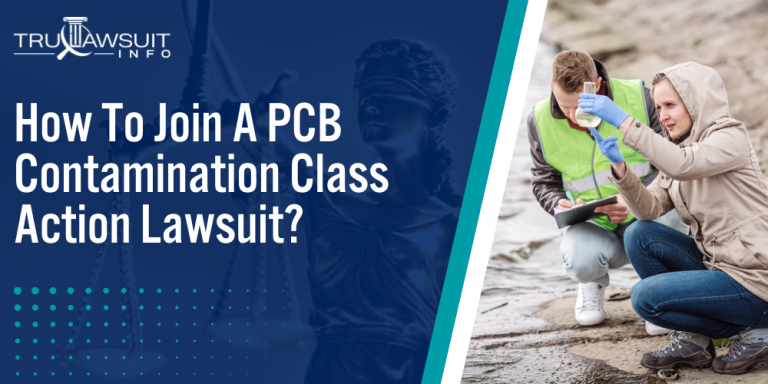
Intro to PCB Contamination
Exposure to PCB-contaminated materials can lurk unseen, but its impact on human health is undeniable, being linked to cancers and other serious illnesses.
If you or a loved one has experienced adverse health conditions after exposure to PCB chemicals, you may be eligible to pursue compensation.
Contact TruLawsuit Info today using the chat on this page to receive an instant case evaluation.
Table of Contents
Legal Framework of the PCB Contamination Lawsuits
The legal framework of the PCB contamination lawsuits involves various federal and state laws, regulations, and court decisions.
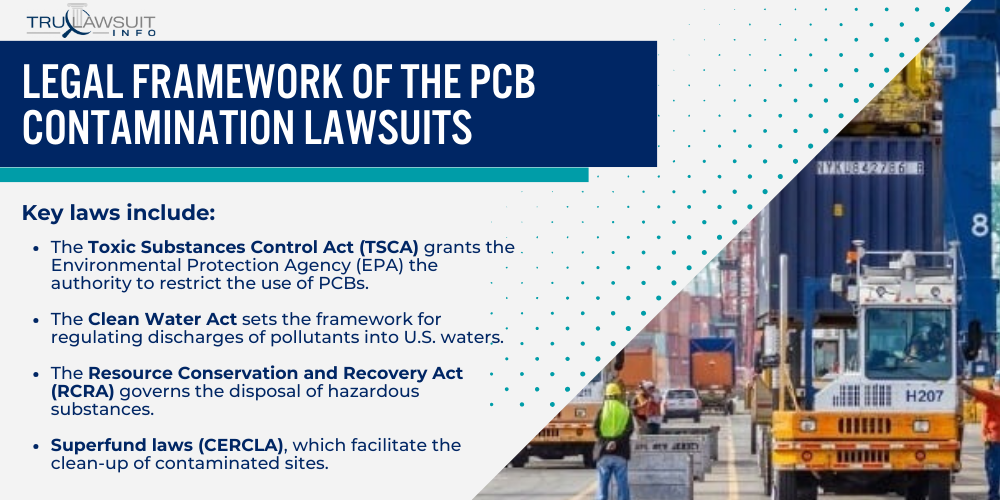
The laws and regulations define the responsibilities of the parties involved and establish the procedures for resolving disputes related to PCB contamination.
Applicable Laws and PCB Regulations
When joining a PCB contamination lawsuit, one must know the applicable laws and regulations.
PCB, or polychlorinated biphenyl, is a toxic substance that falls under the regulation of several federal laws due to its impact on environmental protection and public health.
Key laws include:
- The Toxic Substances Control Act (TSCA) grants the Environmental Protection Agency (EPA) the authority to restrict the use of PCBs.
- The Clean Water Act sets the framework for regulating discharges of pollutants into U.S. waters.
- The Resource Conservation and Recovery Act (RCRA) governs the disposal of hazardous substances.
- Superfund laws (CERCLA), which facilitate the clean-up of contaminated sites.
Past Settlements and Court Decisions: PCB Contamination Lawsuit
Precedent plays a significant role in shaping the likely outcomes and strategies of current and future PCB lawsuits.
Examining past settlements and court decisions offers insight into the judicial landscape surrounding PCB contamination claims.
Noteworthy decisions include:
- A Federal court verdict in 2019 where plaintiffs won a significant settlement against a major corporation for PCB contamination in a local school.
- State court decisions have held companies responsible for cleanup costs under state environmental laws.
- A proposed settlement in a recent class action lawsuit alleging harm due to PCB exposure outlined extensive remediation and compensation efforts.
- Settlement agreements that include medical monitoring for individuals exposed to PCBs over a long period.
Identifying the Responsible Parties In the PCB Lawsuits
When considering PCB contamination lawsuits, the crux lies in pinpointing the companies and entities responsible for creating and distributing PCB chemicals.
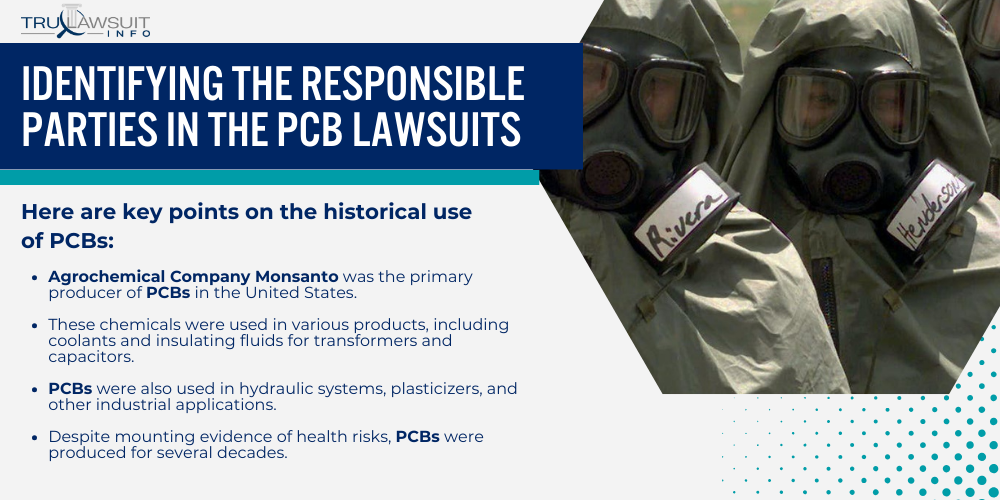
Plaintiffs need to establish a clear connection between their exposure and the negligent actions of these parties.
Historical Use of PCB Chemicals by Corporations
Polychlorinated biphenyls (PCBs) were extensively utilized by corporations, particularly in electrical equipment, due to their non-flammability and chemical stability.
One major corporation that produced PCBs is Monsanto, known to have manufactured these chemicals until they were banned in the 1970s.
Here are key points on the historical use of PCBs:
- Agrochemical Company Monsanto was the primary producer of PCBs in the United States.
- These chemicals were used in various products, including coolants and insulating fluids for transformers and capacitors.
- PCBs were also used in hydraulic systems, plasticizers, and other industrial applications.
- Despite mounting evidence of health risks, PCBs were produced for several decades.
Determining Liability in the PCB Contamination Lawsuit
Determining liability is multifaceted, involving extensive legal and environmental investigations.
It is alleged that Monsanto intentionally misled the public regarding PCBs’ harmful effects.
These factors help in holding Monsanto accountable:
- Documentation of Monsanto’s knowledge of PCB dangers during manufacturing.
- Evidence of failure to warn the public and regulatory agencies about the hazards.
- Correlation of environmental harm with PCB waste from specific manufacturing sites.
- Proof of contamination and resulting human exposure to these highly toxic compounds.
Responsibility may extend beyond Monsanto to include other entities that handled, distributed, or improperly disposed of PCBs, contributing to environmental harm and the need for affected parties to recover costs associated with damages.
Preparing for a PCB Contamination Lawsuit
Initiating legal action for PCB contamination requires careful preparation.
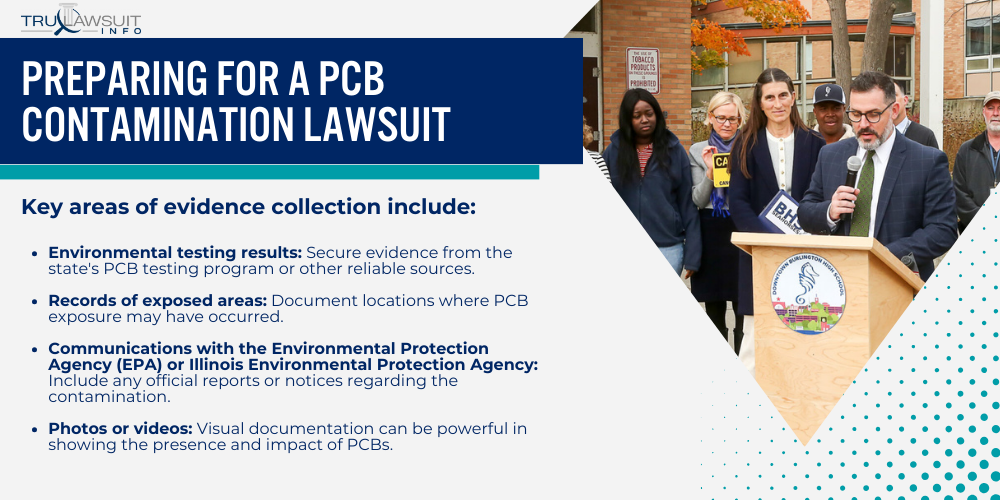
Plaintiffs must adequately document exposure and related health issues to establish a strong foundation for their case.
Gathering Evidence of PCB Contamination
In preparing for a lawsuit concerning PCB contamination, it is essential to gather comprehensive evidence to demonstrate the extent of the pollution and its impacts.
Key areas of evidence collection include:
- Environmental testing results: Secure evidence from the state’s PCB testing program or other reliable sources.
- Records of exposed areas: Document locations where PCB exposure may have occurred.
- Communications with the Environmental Protection Agency (EPA) or Illinois Environmental Protection Agency: Include any official reports or notices regarding the contamination.
- Photos or videos: Visual documentation can be powerful in showing the presence and impact of PCBs.
Health Assessments and Medical Records
For legal claims related to toxic substance exposure, establishing a connection between health issues and PCB exposure is critical.
Essential components of this evidence include:
- Complete medical evaluations: Obtain thorough health assessments from qualified healthcare professionals.
- Documentation of diagnoses related to PCB exposure: This might include conditions related to reproductive systems or reduced birth weight.
- Medical history: Outline past health records to demonstrate changes in human health post-exposure.
- Expert opinions: Consult with medical experts familiar with PCB-related health conditions.
Steps to File a PCB Contamination Lawsuit
Individuals seeking to join a PCB contamination lawsuit must know specific legal procedures and requirements.
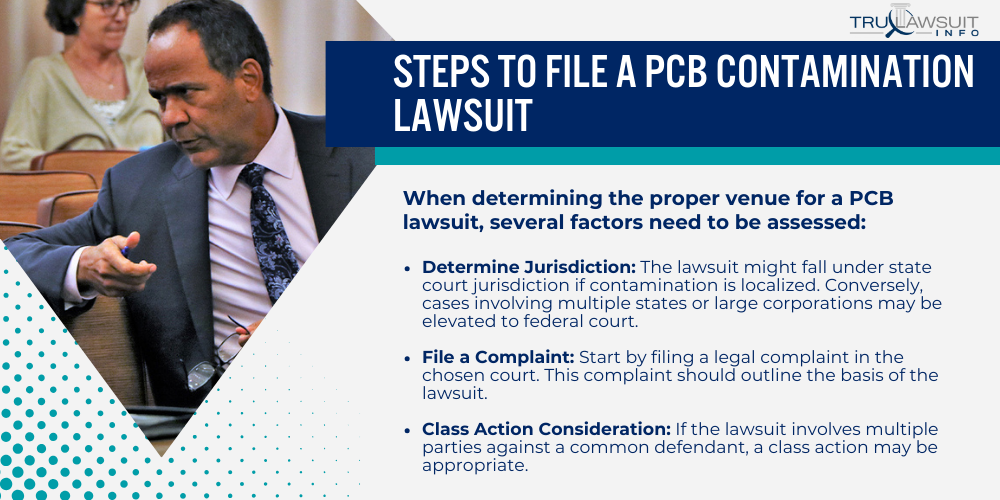
The process involves navigating through different court systems and understanding the types of claims that can be made and compensation measures.
Navigating State and Federal Court Systems
The distinctions between state and federal court systems are crucial to effectively pursue a PCB contamination lawsuit.
Plaintiffs must identify the most strategic court in which to file their lawsuit, considering factors such as the geographical scope of the contamination and the legal domicile of the defendant.
When determining the proper venue for a PCB lawsuit, several factors need to be assessed:
- Determine Jurisdiction: The lawsuit might fall under state court jurisdiction if contamination is localized. Conversely, cases involving multiple states or large corporations may be elevated to federal court.
- File a Complaint: Start by filing a legal complaint in the chosen court. This complaint should outline the basis of the lawsuit.
- Class Action Consideration: If the lawsuit involves multiple parties against a common defendant, a class action may be appropriate.
- EPA Superfund Site Involvement: Additional federal oversight and procedures may apply if the contamination is at a site listed as an EPA Superfund site.
- Pretrial Motions: Be prepared to respond to pretrial motions, which could include a motion to dismiss the case or to move to a more appropriate court.
- Litigation Process: Engage in the litigation process, including discovery, settlement negotiations, or trial.
Claims and Compensation in PCB Lawsuits
Successfully filing a PCB lawsuit requires a thorough understanding of the types of damages that can be claimed and the evidence needed to support those claims.
Individuals should document their exposure to PCBs and the subsequent health, property, or economic losses they have suffered to construct a compelling case for compensation.
Claims in PCB lawsuits must be specific and well-supported:
- Types of Damages: Plaintiffs typically seek compensation for personal injury, property damage, and remediation costs.
- Burden of Proof: The plaintiff must demonstrate with evidence how exposure to PCBs caused their claimed damages.
- Calculation of Compensation: Monetary compensation is determined based on a variety of factors, including the extent of exposure, damages suffered, and costs incurred.
- Punitive Damages: In certain cases, plaintiffs may also seek punitive damages if the behavior of the defendant was particularly egregious.
Case Studies Mentioned in the PCB Lawsuits
Polychlorinated Biphenyls (PCBs) have been the focus of numerous legal actions due to their impact on public health and the environment.
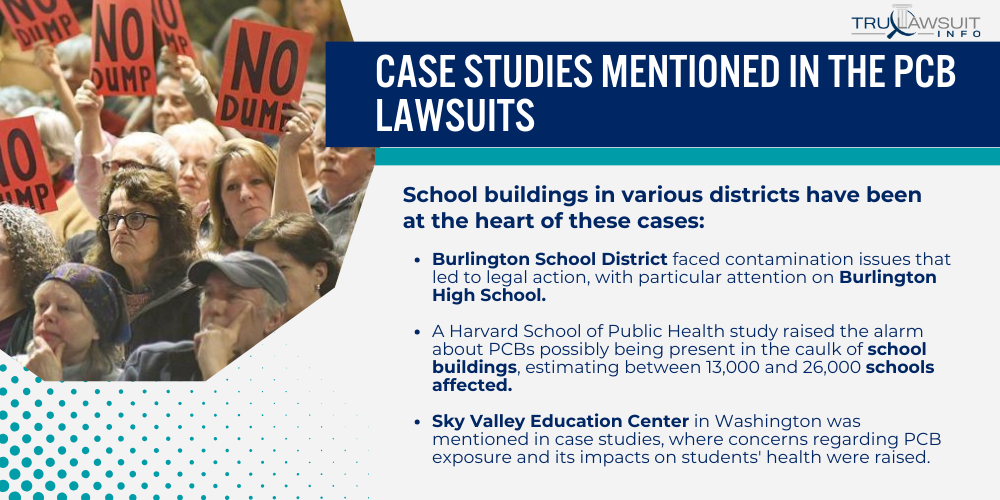
The following subsections provide insight into specific case studies featured within these lawsuits, highlighting the experiences of school districts and urban communities.
School Districts and PCB Contamination
The involvement of school districts in PCB lawsuits underscores widespread concerns about the presence of these toxic substances in educational settings.
School buildings in various districts have been at the heart of these cases:
- Burlington School District faced contamination issues that led to legal action, with particular attention on Burlington High School.
- A Harvard School of Public Health study raised the alarm about PCBs possibly being present in the caulk of school buildings, estimating between 13,000 and 26,000 schools affected.
- Sky Valley Education Center in Washington was mentioned in case studies, where concerns regarding PCB exposure and its impacts on students’ health were raised.
- In 2021, the Vermont Legislature passed Act 74, requiring all schools built or renovated before 1980 to test their indoor air for PCBs.
- In Vermont schools, the discovery of PCBs has prompted both concern and subsequent litigation focused on ensuring safe learning environments for students.
Cities and Communities Fighting PCB Contamination
PCBs are toxic chemicals that were widely used in industry until they were banned in the 1970s.
Despite the ban, PCB contamination remains a significant problem in many cities and communities worldwide.
Efforts to combat PCB contamination have led to noteworthy initiatives and legal actions across various locales:
- Lake Michigan, a crucial water resource for many communities, has been central to discussions in legal cases due to PCB contamination concerns.
- In Chicago, Mayor Brandon Johnson has been vocal about the need to protect Chicago’s neighborhoods from environmental pollutants like PCBs.
- Numerous municipal entities involving about 2,500 have come together to address the adverse effects of PCBs on their community’s wellbeing, leading to a significant settlement agreement in recent years.
The Role of Government Agencies in Addressing PCB Contamination
Government agencies like the Environmental Protection Agency (EPA) and state-level bodies are crucial in tackling PCB contamination.
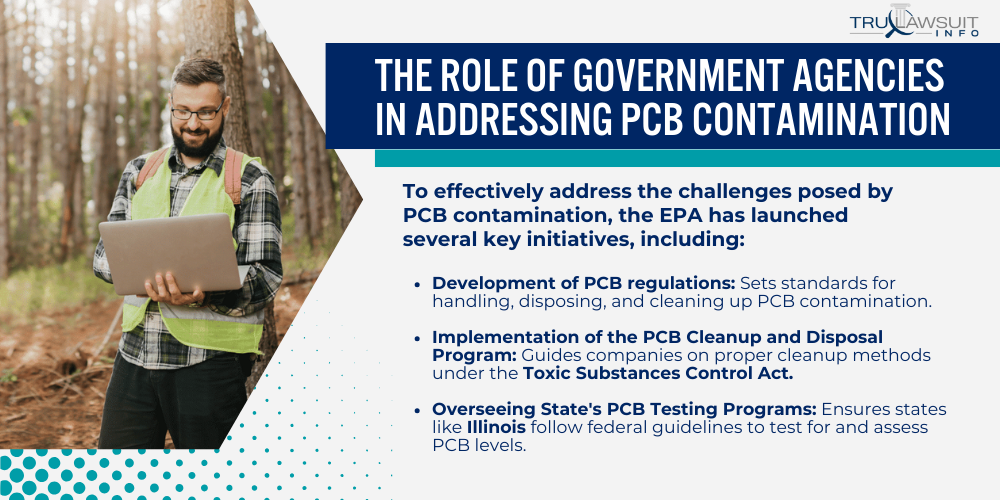
EPA and State-Level Initiatives: Removing PCBs
The EPA has been at the forefront of addressing polychlorinated biphenyls (PCBs) through targeted initiatives.
To effectively address the challenges posed by PCB contamination, the EPA has launched several key initiatives, including:
- Development of PCB regulations: Sets standards for handling, disposing, and cleaning up PCB contamination.
- Implementation of the PCB Cleanup and Disposal Program: Guides companies on proper cleanup methods under the Toxic Substances Control Act.
- Overseeing State’s PCB Testing Programs: Ensures states like Illinois follow federal guidelines to test for and assess PCB levels.
- Supporting Research Initiatives: To understand the impact of PCBs on natural resources and public health.
State agencies, such as the Illinois Environmental Protection Agency, implement these initiatives at the local level, customizing efforts to address regional contamination issues.
Public Resource Allocation and Cleanup Efforts
Resource allocation is a key function of government agencies to combat PCB contamination.
Here’s how they apportion funds and organize cleanup efforts:
- Financial Support: Allocating taxpayers’ money, as seen with Vermont taxpayers, to fund cleanup projects.
- Cleanup Operations: Spearheading comprehensive cleanup projects to address PCB contamination.
- Community Involvement Plans: Engaging residents and businesses to contribute to remediation efforts.
- Inter-agency Collaboration: Agencies like the Fish and Boat Commission work together to protect waterways.
Impact of PCB Contamination Lawsuits on Future Policy
PCB contamination lawsuits catalyze tighter regulations and increased corporate responsibility, influencing policies that safeguard public health and the environment for future generations.
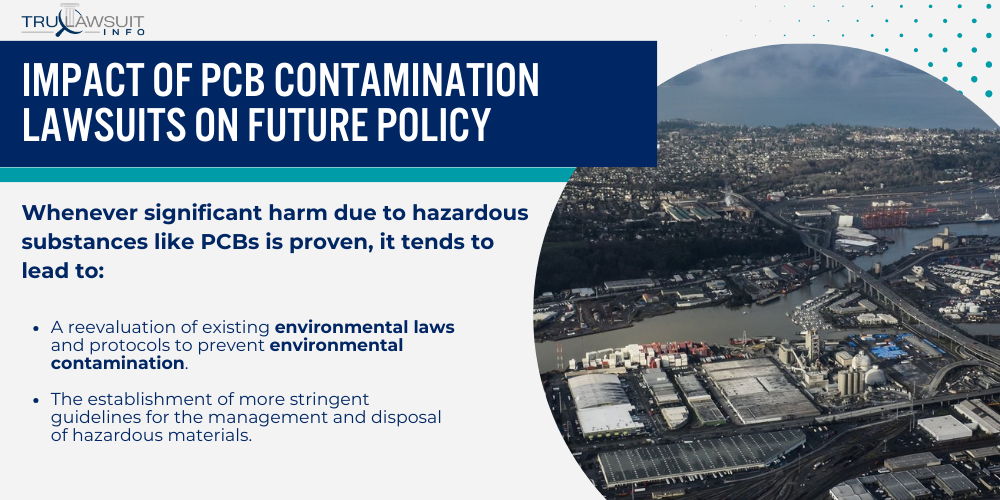
Changing Regulations and Corporate Accountability
PCB contamination lawsuits have been instrumental in driving the enforcement of stricter environmental regulations and ensuring corporate accountability.
Whenever significant harm due to hazardous substances like PCBs is proven, it tends to lead to:
- A reevaluation of existing environmental laws and protocols to prevent environmental contamination.
- The establishment of more stringent guidelines for the management and disposal of hazardous materials.
- The legal framework to hold Monsanto accountable must be strengthened, as they were a primary manufacturer of PCBs.
- Increasing pressure on industries to adopt safer alternatives to lessen potential health risks.
Protection of Public Health and the Environment
The protection of public health and the environment is paramount in the ongoing battle against PCB contamination.
Through litigation and regulation, we strive to mitigate the impact of PCBs on our communities and natural habitats.
The outcomes of PCB lawsuits shape policies that focus on:
- Preventing future generations from the dangers of PCB exposure.
- Ensuring environmental protection measures are in place to avert significant harm.
- Providing clear requirements for cleanup efforts to remediate environmental contamination.
- Establishing health monitoring programs for communities affected by PCBs.
Frequently Asked Questions
-
What steps do I need to take to join a PCB contamination class action lawsuit?
To join a class action lawsuit, one must first verify the existence of an ongoing case.
If an action is open, reaching out to the law firm handling the case for inclusion is the next step.
-
How can I determine if I am eligible for a PCB contamination lawsuit settlement?
Eligibility typically depends on evidence proving exposure to PCBs and subsequent harm.
Individuals must generally show medical records or diagnostic results as proof of health issues related to PCB exposure.
-
What type of evidence is required to participate in a Monsanto PCB lawsuit?
Critical evidence includes medical documentation of any health effects believed to be caused by PCBs.
Documentation of PCB presence in the individual’s environment is also required to establish the link between the exposure and the health condition.
-
How do I find out about active PCB lawsuits in my state?
One can consult a legal professional specializing in environmental law or check databases listing class action lawsuits.
Legal advocacy groups or online search tools tailored to class action cases can also provide current information.
-
What is the process for receiving compensation from a PCB class action settlement?
Once a settlement is reached, the court typically orders the creation of a settlement fund.
Claimants must submit a claim form with supporting documents.
After that, compensation distribution follows court-approved criteria.

Experienced Attorney & Legal SaaS CEO
With over 25 years of legal experience, Jessie is an Illinois lawyer, a CPA, and a mother of three. She spent the first decade of her career working as an international tax attorney at Deloitte.
In 2009, Jessie co-founded her own law firm with her husband – which has scaled to over 30 employees since its conception.
In 2016, Jessie founded TruLaw, which allows her to collaborate with attorneys and legal experts across the United States on a daily basis. This hypervaluable network of experts is what enables her to share reliable legal information with her readers!
Have A Case?
Here, at Tru Lawsuit Info, we’re committed to helping victims get the justice they deserve.
To do this, we actively work to connect them with attorneys who are experts in litigating cases similar to theirs.
Would you like our help?
Tru Lawsuit Info is a reliable source of information about issues that may affect your health and safety, such as faulty products, data breaches, and environmental hazards.
Our team of experienced writers collaborates with medical professionals, lawyers, and advocates to produce informative articles, guides, and other resources that raise awareness of these topics.
Our thorough research provides consumers with access to reliable information and updates on lawsuits happening around the country. We also can connect consumers with attorneys if they need assistance.
Camp Lejeune's water contamination issue spanned several decades starting in the 1950s. Exposure to these chemicals has been linked to various serious health issues, including cancer, organ diseases, and death.
Research is increasingly suggesting a link between the use of Tylenol during pregnancy and the development of neurodevelopmental disorders, such as autism and ADHD, in infants.
Legal action is being taken against manufacturers of Aqueous Film-Forming Foam (AFFF), a chemical used in fighting fires. The plaintiffs allege that exposure to the foam caused health issues such as cancer, organ damage, and birth and fertility issues.
Have A Case?
Here, at Tru Lawsuit Info, we’re committed to helping victims get the justice they deserve.
To do this, we actively work to connect them with attorneys who are experts in litigating cases similar to theirs.
Would you like our help?







